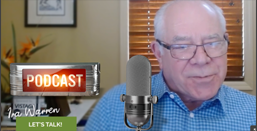An unexpected consequence of the pandemic was the success of the forced “worked from home” experiment which proved it was feasible for many knowledge workers to move most, and in many cases all, of their work lives to their homes. The resulting hot single family home market and the ailing commercial office building market are the most notable consequences of this, perhaps nowhere more visible than New York City. Many hope the departure of Covid will restore the Big Apple and other major metropolitan marvels to their former glory. Native New Yorker, WSJ columnist and speechwriter to the late President Ronald Reagan Peggy Noonan isn’t so sure.
She looks at the impact of Covid on her beloved New York with wisdom, insight and more than a little sadness. Other significant events such as the Civil War, the 1918 Influenza pandemic and World War II blocked a return to life as we knew it. In some ways we profited; in others we have suffered loss. Ms. Noonan’s WSJ article “The Old New York Won’t Come Back” acknowledges this reality with a thoughtful and realistic analysis that may help many of us to project the future of our own cities ….and lives.
6 Little Predictions
While we’re on the topic of what happens next, check out former PC World /Info World Columnist and PBS Tech documentarian author Robert X. Cringely ‘s recent blog predictions on what’s ahead for society at large in 2021. He writes “I think this pandemic will have greater long-term effects than that of 1918 and the reason comes down mainly to technology. Check out his “Half a dozen little 2021 predictions about life after COVID-10”
A New Marketing Decalogue
Peter Drucker once remarked that “the aim or marketing is to know and understand the customer so well the product or service sells it itself.” But what has Covid done to the marketing function? It’s changed so many other aspects of business that if, as Drucker further commented that “marketing is….the whole business seen from the customer’s point of view” we can hardly afford not to explore how marketing will change post pandemic.
This short post from HBR by Janet Balis who heads Ernst and Young’s Chief Marketing Officer Practice looks at a ten marketing truths as they existed before Covid and how the pandemic has altered them; some subtly, some significantly. Share this with your sales and market teams and review your marketing function in light of “10 Truths About Marketing After the Pandemic.”
Less Division on Unity
It’s no secret that many Americans on all parts of the spectrum are concerned about the lack of unity in the country. A recent survey showed that 82% of Americans feel the country is more divided than united. However, additional research indicates “That sentiment of division is just not matched by private opinion. It turns out that the answers depends on survey methodology designed to get around social pressure to get at private values.”
A short segment on CNN’s “Smerconish” explains why. It features an interview with the head of opinion research firm Populace, Todd Rose. His firm’s methodology indicated remarkable national unity on 8 of 10 key issues, some of which may surprise you. It turns out that how you inquire about divisive issues is as important as the question itself. The real issue according to Mr. Rose is ‘less that we fiercely disagree but that we profoundly misunderstand each other.” Worth the seven minutes for a unique, and hopeful, perspective.
A Little Fun
Millions watched Oprah interview royals Harry an Megan last Sunday. But did you know that Oprah subsequently interviewed two members of the Biden family who recently had an altercation with White House Staff? One of the Biden’s German Shepherds, Major, allegedly took exception to one of the Secret Service team and was exiled from the White House back to the Biden home in Delaware. Always wanting to share both sides of the story, Oprah invited the Biden’s canines to share their version. Check out “Oprah Sits Down with Major and Champ.”
Covid Tracker-
Check out Dr. Brian Wesbury’s Covid tracker as of March 9, 2020 In the upper left corner you’ll see that daily reported new positive cases continue their downward trajectory, but with a bit of recent plateau.
Another good source is https://www.worldometers.info/coronavirus/ and the oft cited IHME (Institute for Health Metrics) Projections. Both offer data and projections by country and state. Please, keep wearing your mask…it’s making a difference! Get vaccinated as soon as it’s available to you!
Econ Recon
Roosevelt Redux: It’s dangerous to make something as complex as economics too simple, but clearly one key driver of the economy is what people believe. Beliefs ultimately drive decisions and the consequent actions that constitute the economy in terms of consumption, investment or the government’s policy decisions (in my armchair economist’s opinion). Leaders have long understood this. To wit, President Franklin Roosevelt’s encouragement to his fellow Americans during the early days of the depression that “All we have to fear is fear itself.”
Economist Brian Wesbury agrees with FDR and tries to place the dynamics of the pandemic in that context. Deaths and hospitalizations are dropping quickly but the prospect of more contagious and or deadly variants may also impact fear, confidence and economic decision making. Dr. Wesbury offers a hopeful view of what’s ahead sorts it out for you in his latest Wesbury 101 video. His thoughts on the equity markets are provocative.
Whither the Workers?…3 questions before proceeding: Much of the media is focused on the still relatively high rate of unemployment due to the pandemic but the press often fails to share that the rate has been rapidly dropping. More to the point, if you ask business leaders, the market for labor is tight and getting tighter. Economist Lauren Saidel-Baker ITR Economics provides a more complete picture of the employment reality and offers a few coping strategies for C-Level leaders in her blog post “Where are the Workers?” While you’re on the ITR site, check out another blog post by Alex Chausovsky, ITR Senior Business Advisor, who writes “ The US industrial economy is on track for imminent business cycle rise.” He advises you prepare by asking yourself 3 questions to ready yourself for a rising business cycle.






